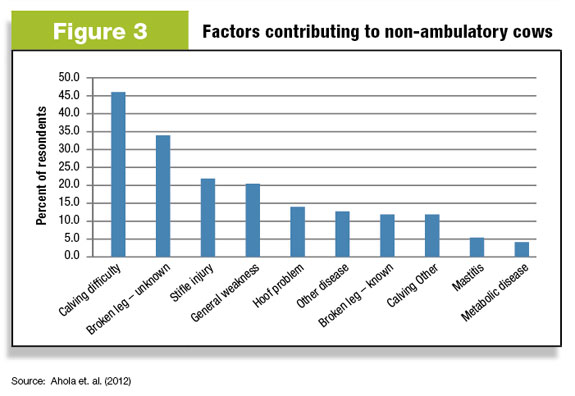When combined, these animals made up approximately 20 percent of all cattle harvested.
Cull cows (aka “market” cows) represent an important part of the total beef supply since they are widely used to supply beef to consumers via retail and food service outlets as both primal cuts and ground beef.
The relative value of market cow carcasses will likely continue to increase based on data from the 2007 National Market Cow and Bull Beef Quality Audit, in which the percentage of cow carcasses fabricated into higher-priced, whole-muscle cuts is increasing.
This underscores the need to communicate to beef producers their critical role in the U.S. beef supply chain.
However, limited improvements have been made in addressing quality challenges specific to the market cattle population identified in previous audits in 1994 and 1999.

Non-ambulatory cattle
The existence of non-ambulatory cattle in the U.S., or cattle that have the potential to become non-ambulatory if subjected to a stressor (i.e. long-distance transport to slaughter), has become an animal welfare concern.
This has primarily been caused by several instances of national media attention focused on undercover videos showing the mishandling of non-ambulatory cows.
Only recently has the cattle industry begun to address this issue through research, science-based management recommendations, and Beef Quality Assurance (BQA) educational programming.
During the interview portion of the 2007 audit, “animal welfare” issues and “condemnation rates of downers prior to slaughter” were both included on the list of “Top 10 Quality Challenges” that faced the market cow and bull beef industry from 1999 to 2007, based on interviews with packing plant management and USDA personnel.
One of the most improved antemortem traits for cattle, however, was the reduced prevalence of non-ambulatory animals between 1999 and 2007, which was most likely due to implementation of the 2004 ban on harvesting non-ambulatory cattle.
Few estimates of non-ambulatory incidence in the U.S. cattle industry are available. Survey data collected in 2004 by the United States Animal Health Association (USAHA) estimated that 0.40 percent of all beef and dairy cattle nationwide (including all cows and calves) were non-ambulatory for some reason at some point during the year. This equates to nearly 400,000 non-ambulatory cattle occurring annually.
Since the initiation of the market cow audits in 1994, data collection related to quality defects and non-ambulatory status in market cows and bulls has focused primarily in packing plant holding pens.
More recent research evaluated the presence of quality defects at livestock auction markets, but the incidence of non-ambulatory cattle was not evaluated. Additionally, few studies have investigated the leading causes of non-ambulatory status in market cattle.

Producer survey conducted
In early 2011, a 29-question survey was mailed to 9,778 California cattle producers to characterize how they marketed cull cows and also to document specific characteristics producers believed contribute to market cattle becoming non-ambulatory. Completed surveys were received from 403 beef producers.
When asked “What is the primary method of marketing your cull/market cows?,” survey respondents clearly indicated that a livestock auction market was used more than any other option.
The direct sale of market cows to a beef packer was the second-most common outlet. Beef operators also used order buyers and other methods, both at a greater rate than buying stations.
Due to the fact that the majority of market cattle are sold via livestock auction markets, future educational efforts aimed at reducing non-ambulatory animal incidence should be focused primarily on the relationship between cattle producers and livestock market owners.
In the survey, respondents also reported the percent of their cowherds that were culled, euthanized and died of natural causes during the previous 12 months.
Based on summarized responses, 10.8 percent of cows were culled annually. Further, respondents estimated that 78.2 percent of these cows went directly to slaughter (vs. being purchased by another producer).
On average, respondents surveyed indicated that they euthanized 1.2 percent of their beef cows on-farm or on-ranch during the previous 12 months.
The existence of euthanasia, albeit at a relatively low rate, suggests that some producers are actively working to avoid non-ambulatory problems in the marketplace by euthanizing cattle instead of selling them into the marketplace. An estimated 1.3 percent of beef cows died of natural causes.

Non-ambulatory incidence and causes
When asked about the incidence of non-ambulatory animals on their operations, 65.4 percent of beef respondents indicated they have not had a non-ambulatory cow in the previous 12 months.
However, 18.1 percent of operations had at least one cow, while two or more cows occurred on 16.5 percent of operations. Ultimately, about one-third of cattle operations are dealing with non-ambulatory cows at some level on their operation on a regular basis.
One of the main goals of the survey was to document factors that beef producers feel contributed to a cow becoming non-ambulatory.
This should allow for the identification of critical control points producers can focus their energy on in order to ultimately reduce non-ambulatory incidence. When provided with a list of possible factors contributing to non-ambulatory status, 46.5 percent of respondents indicated that calving difficulty was clearly the primary cause of the incidence of non-ambulatory cows.
Respondents also indicated that a broken leg (with no known cause) was the second-largest contributor to non-ambulatory status. Stifle injury and general weakness were also noted as significant causes.
Based on results of this survey, producers can take immediate action by addressing key issues that contribute to non-ambulatory status – particularly reducing calving difficulty and avoiding broken bones.
In addition, producers are able to benchmark their operations vs. surveyed producers to determine
how their rates of culling, euthanasia and death compare to other producers. ![]()
Editor’s note: This survey was conducted as collaboration between faculty at California State University – Chico, Colorado State University, and Oklahoma State University. Funding was provided by the California State University Agricultural Research Institute.









